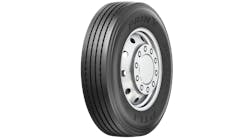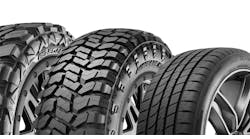Uncertainty about ag tire load speed index continues to abound. In this edition of AG Tire Talk, farm tire manufacturer and equipment supplier representatives tackle this issue by answering the following question:
QUESTION: How do you choose the best load speed index, what is the impact of increased flexion (IF) and very high flexion (VF) technologies, and how does changing from transport speed to in-field operation impact air pressure requirements?
Harm-Hendrik Lange, agricultural tires field engineer, Continental Tire the Americas: Start with the simplest component: the speed symbol, which is the maximum speed the tire is designed for. It correlates with load index, as a standard tire can carry even more if the speed is lower. For agricultural tires, the most common speed symbols are A8/25 mph, B/31 mph and D/40 mph. If your tractor runs faster than 25 mph, you will need the B or D rating. If your tractor is 25 mph or lower, A8 is fine.
A little more complicated is the load index, which is always related to a certain speed and to the inflation pressure. Here’s a practical example for a size 710/70R42 tire: the tire is rated with 173 D, so it can carry 14,330 pounds at 40 mph. If you have a tractor with a maximum speed of 25 mph, the load can be increased by going down three speed symbols. This allows you to increase the load index three steps, meaning the 173 D tire becomes a 176 A8 tire, and can now carry 15,652 pounds at 25 mph.
The third influence is inflation pressure. Higher inflation pressure means higher load capacity. Therefore, the maximum load index and speed symbol are always given at the maximum allowed inflation pressure at maximum speed, called “nominal pressure.”
A farmer should choose a tire by its ability to be operated with low inflation pressure in the field, instead of looking at the maximum load index and speed symbol for road conditions. To run a standard tire at maximum speed with a high load on the road requires a significantly higher inflation pressure.
Ken Brodbeck, vice president of technology, Precision Inflation LLC: First, be sure to have a speed rating that meets or exceeds the maximum speed of your machine. Most radial tires are at least A8 (25 mph) or B (31 mph.) Newer-technology tires are D (40 mph.) Next, be sure to have a load index that meets or exceeds the maximum weight requirements of your machine, configured with the implement you have chosen. Tire dealers and tire manufacturers list these values in their data books and online.
Inflation system technology improves the performance of IF and VF tires. In fact, every radial tire works better with a central tire inflation system to optimize the performance of farm equipment.
Dave Graden, operational market manager, agriculture, Michelin North America Inc.: On the sidewall, you will find a load speed index – for example, 167 B. The first three numbers are the load indices, or weight, a tire can carry. A8, B or D, indicates the speed rating of the tire. Both weight carrying capacity and speed requirements must be assessed in order to choose the proper load speed index.
Physics enables a standard tire to carry load with significantly less air pressure at slower speeds. This is very important if you are concerned with reducing soil compaction. For example, a size 800/70R38 tire carrying a maximum load of 14,330 pounds at 23 psi at 40 mph (transport) can carry the same weight at 6 mph with 15 psi (field.) Reducing pressure by eight psi over 5,000 acres equates to a significant improvement in the grower’s bottom line.
How do you change air pressure from road transport to field quickly during crunch time? By using a central tire inflation system. Do you want to take air pressure savings to another level? IF/VF tires can do that even more. In sum, determine the required weight carrying capacity, determine in-field and road transport speeds and then invest in a central tire inflation system. And to really maximize yield, go VF.
James Crouch, national product manager, agriculture, Alliance Tire Americas Inc.: Load and speed index represent vital information. If you buy a tire with too low of a load/speed index to cover your needs, you could overload the tire. This can lead to premature wear, accidents and spills. You need to match the load and speed index of your tires to the machinery they will be running on.
Be sure to calculate your need for load and speed based on the real-world weight of each axle. You have to look beyond the machine’s shipping weight to also account for the weight of fuel, spray solution, ballast and load on the drawbar. If it has a bucket on the front, add the weight of a full load of dirt. Be real about what you’re going to be doing with that machine and you will end up with an accurate load index.
The same goes for speed. If you’re going to operate at a higher speed, check your inflation tables to match the load, speed and optimum inflation pressure. If your pressure is too low for your load and speed, your sidewalls will flex too much and build up extra heat, which can result in excessive stress on the tire carcass and ultimately could destroy the tire.
That’s where IF and VF technology come in. The special design and materials in IF and VF sidewalls allow us to operate these high-tech tires at lower inflation pressure without giving up load and speed. In fact, the load rating of an IF tire at a particular inflation pressure is 20% higher than the load rating of a standard radial at the same pressure. With VF tires, the bonus load capacity is 40%.
To get the full benefit of IF and VF technology, check the inflation tables and make sure you run at the proper pressure for the load and speed that reflect your operating conditions. And to really stay in step with the load/speed index and optimal tire performance, a central tire inflation system is the ultimate tool. This technology is surprisingly affordable and allows you to increase pressure to run safely on the road and decrease it for better performance and lower soil compaction in the field.
Scott Sloan, ag product manager/global LSW, Titan International Inc.: I think it would be beneficial to review tire technologies and what they offer. Conventional tires are just that. They have been around since the dawn of the pneumatic tire. IF tires are designed to carry the same load at 20% less inflation pressure than a conventional tire of the same size. VF tires are designed to carry the same load at 40% less inflation pressure than a conventional tire of the same size.
The theory behind IF and VF technology is that as the tire deflects more, the footprint becomes larger and the larger footprint means less ground-bearing pressure and ultimately less compaction.
Tractor manufacturers do a god job of offering the appropriate load and speed index tires on tractors coming out of the factory, If a grower is in need of a replacement tires, my quick answer is to replaced it with a similar-rated tire. Things get a bit more complicated if the grower is attempting to make a tire technology change.
For instance, if the grower is looking at converting a mechanical front wheel drive tractor from conventional to IF/VF technology, not only will they need to replace all of the tires on the tractor but they also will need to choose a load index that suits the tractor at its heaviest. (See sidebar for more information.)
At the end of the day, the grower needs to decide what is best for their operation. Converting to new technology on an existing tractor is not cheap. They need to weigh the benefits versus the cost. If they do decide, it’s best they understand the technologies, and what gets them the biggest bang for their buck. In addition, doing the research and understanding loads and applications will give them the best chance of being successful with the conversion.
Dave Paulk, manager of field technical services, BKT USA Inc.: Speed and load ratings have become more important with the influx of tractors and equipment coming into the U.S. from Europe. When choosing a tire, the weight carrying capacity for the weight of the tractor, the intended load and transportation speed should all be considered. The load and index speed of a tire follow the size on the sidewall of the tire. Charts are available to show the maximum load capacity of a radial tire at the maximum speed. A tire may have a 154 D/157 A8 load and speed index rating. This means the tire will carry 8,250 pounds (154 load index) at 40 mph (D speed rating) at 35 psi. This same tire will carry 9,090 pounds (157 load index) at 25 mph (A8 speed rating) at 35 psi. The higher the speed, the less weight a tire can handle.
Radial farm tires are designed to run at lower air pressures in the field at field speeds (five to 10 mph.) Tires may need more air pressure to transport equipment on the highway than they do in the fields. Sidewall damage and sidewall separations can occur when tires are run overloaded and under-inflated. Realizing that time is precious during planting and harvest, money can be saved by running the correct air pressures for the application and usage during these periods. Air inflation systems are now being offered as aftermarket items, but manufacturers are looking at them as original equipment options to minimize tire damage and premature failure.
IF and VF technology enable a tractor to carry more weight without having to widen the tire to the point where it can’t be transported on the highway. This technology also can be used to reduce air pressure to minimize soil compaction in areas where no-till and minimum-till are used. If an IF or VF tire is being used, air pressure can be reduced to carry the same weight as a standard tire. This decreases ground bearing pressure and thus reduces soil compaction.
On the opposite side of the spectrum, sometimes a higher weight carrying capacity is needed. An example is radial implements on planters and cultivators where a bias-ply implement tire will not carry heavier weights. A VF-rated tire also is good for sprayers, as they run at higher speeds and can handle weight capacities.
There are still a huge number of bias-ply farm tires running in the U.S. market. Bias-ply tires, unlike radial farm tires, are not made to run at low pressures. If bias-ply tires are being used, the load carrying capacity should be checked to make sure they are not being overloaded.
Bradley Harris, manager, global agricultural field engineering, Firestone Ag Division, Bridgestone Americas Tire Operations LLC: The load speed index is the identification system that replaces the tire ply rating and the star rating. Utilizing the best load speed index will lead to a better purchase when choosing the right tire for your operation. The specific load index value is equivalent to the rated load for any tire sizes. The speed rating of the tire follows the load index. It is always important to match the maximum speed of the tire to the maximum speed rating of the tractor. In North America, B-speed rated tires will be acceptable for most tractors.
With IF and VF technology, the load index value increases when comparing same-size tires. When setting inflation pressures, axle loads and operating speeds are critical. Without having a central tire inflation system on your tractor, the inflation pressure needed is based on the fastest travel speed and the maximum axle load. If the tractor is only being used to haul equipment, like a disc or field cultivator, there is not a weight difference between field applications and road transport. Once the pressure is set, there is no need to adjust applications.
Understanding load index and speed ratings will allow you to make an educated decision when choosing your next set of tires.
Greg Gilland, business development and ag segment manager, Maxam Tire International: Each agricultural operation requires equipment designed to maximize the harvest of that chosen crop. In the case of tractor applications, the choice of machine size and horsepower selected will dictate the size of tires that will be employed. Agricultural tires are designed — based on their size geometry, materials and air chamber — to carry a certain amount of weight at a given ground speed and to fit a certain wheel base.
All radial ag tires employ the tire carcass to carry 20% of the tire’s load, with the compressed air in the tire chamber carrying 80% of the remaining weight. Ag tires are therefore rated by a common index to identify their load capability at a given speed.The key objective of any given machine utilizing tires in a farming operation is to choose the optimized air pressure that can carry the maximum weight expected, while providing the least amount of soil compaction. The yield of crops produced is directly impacted by the amount of ground pressure caused by the weight of machinery due to topical soil pressure or soil compaction caused by equipment working in the field. To maximize the utilization of IF and VF technology tires, growers should consider adjusting the air pressure of their tires as they modify the weight being pulled or the load being carried. Higher transport speeds will demand higher air pressure to sustain the weight and/or corresponding speed to move ag equipment from the barn to field, or from field to field. Newer tractors and ag equipment are utilizing on-board inflation equipment to quickly adjust IF or VF tires up or down in air pressure to the optimal footprint needed. The right air pressure for the right load is the answer to improved ag profits.
Norberto Herbener, OE applications engineer, Trelleborg Wheel Systems Americas Inc.: Each tire has a specific load index and speed symbol, and both together are referred to as load speed index. The load index represents the load capacity at the nominal inflation pressure of the tire. There is a direct correlation between load capacity and inflation pressure: the higher the pressure, the higher the load capacity. These values depend on the tire size (width, ratio and rim diameter) and are all normalized by the Tire & Rim Association in the United States.
The speed symbol represents the speed which the load index refers to. A large combine flotation tire will normally have a speed symbol of A8 that represents 25 mph. On a sprayer tire, the speed symbol will be a D, representing 40 mph. On conventional tires, the reduction of working speed allows higher load capacities. This can be explained by the fact that at higher loads, the tire’s temperature increases — and the temperature increases also when the speed is increased. So when we reduce speed, we compensate for the temperature increase by increasing the load.
When looking at a tire manufacturer’s manual, you will see that for each conventional (or non-IF and VF) tire sizes, there is a specific data matrix with inflation pressures and speed. Each combination will specify the maximum load capacity of that tire. So when a farmer wants to know what inflation pressure he needs, first he must know the load each tire will carry and the speed he will use for that load. With these two values, he can determine the correct inflation pressure.
When talking about newer and higher tire technologies, we must talk about IF and VF tires. Both technologies allow higher load capacities — 20% higher for IF and 40% higher for VF — at the same inflation pressures for the same size compared to conventional tires. ■



